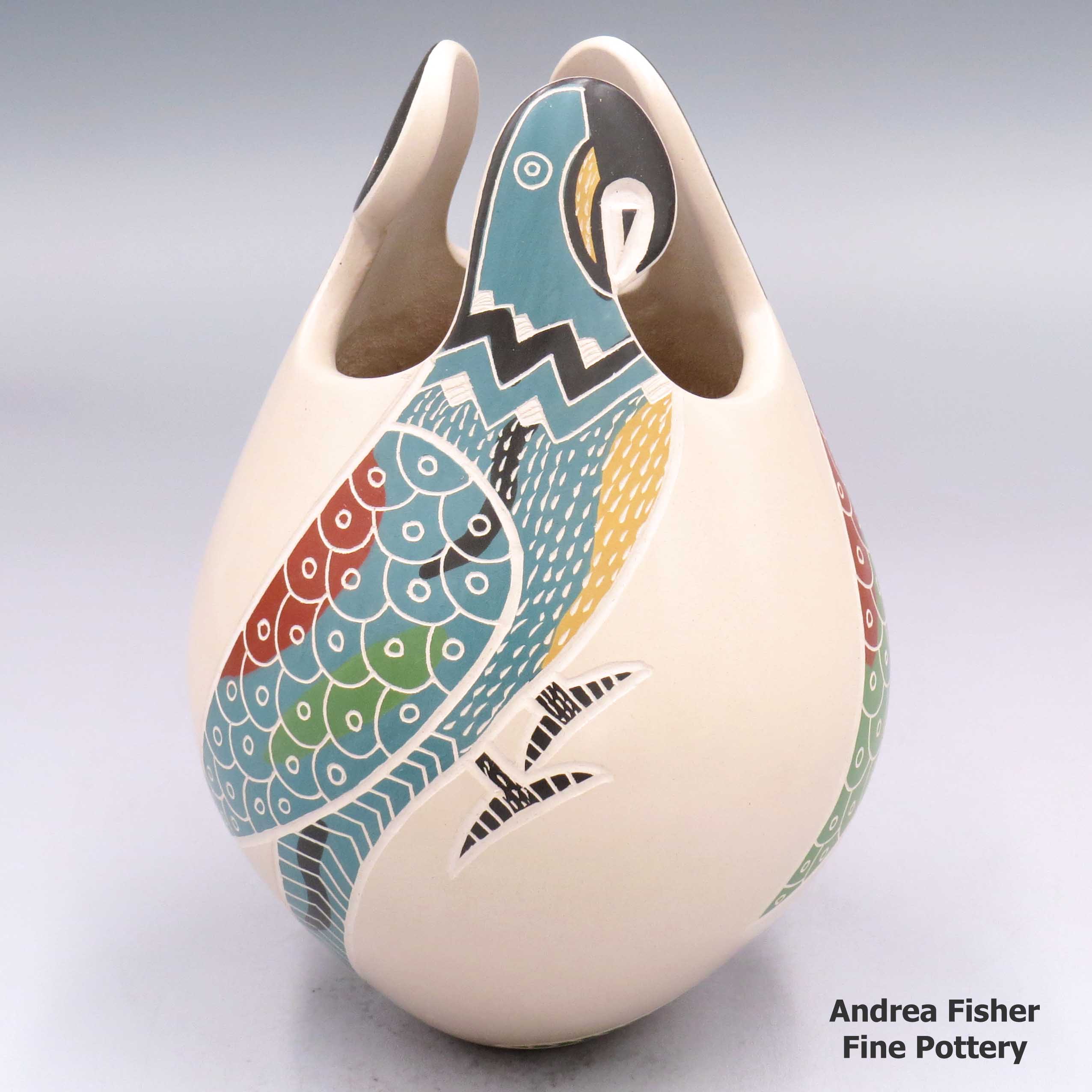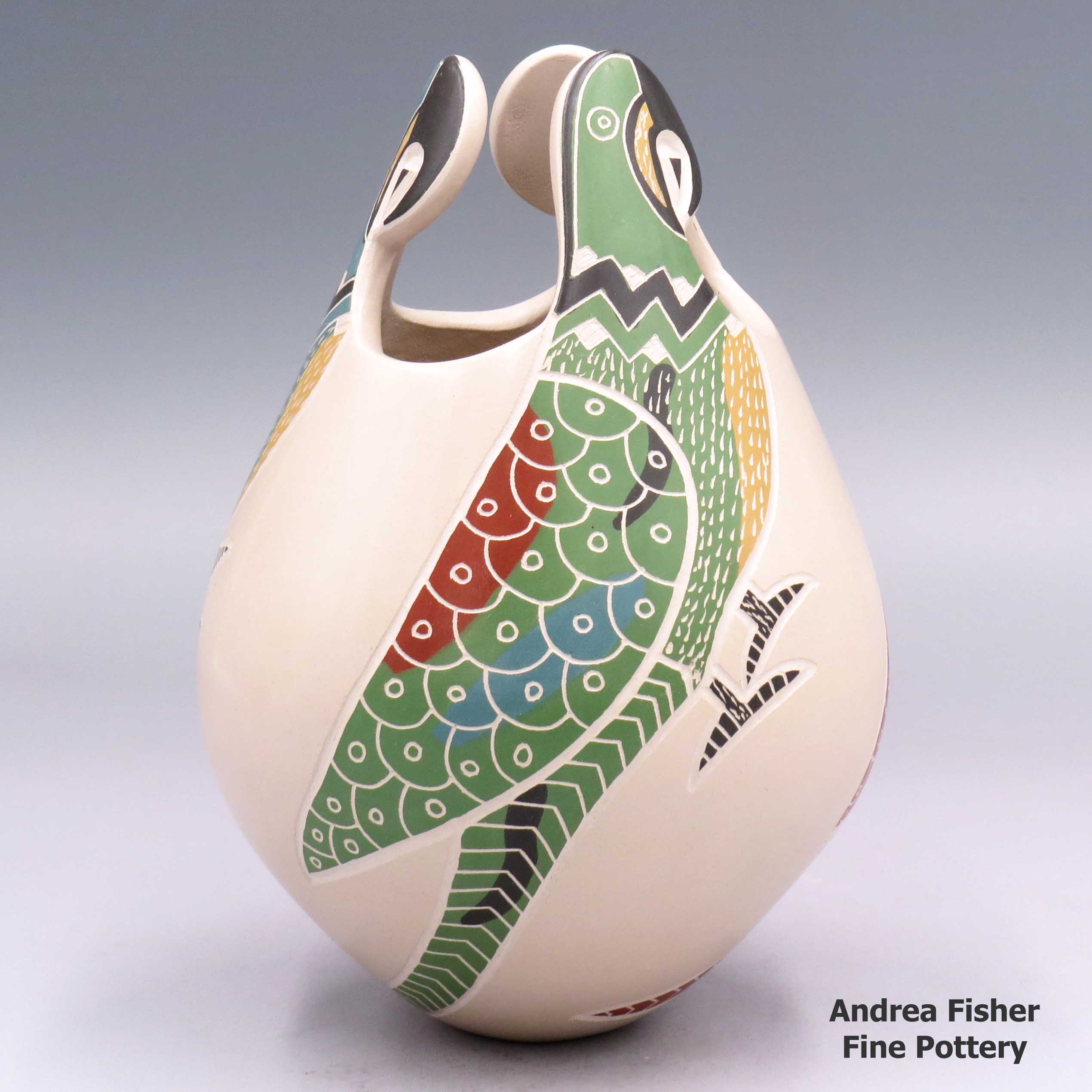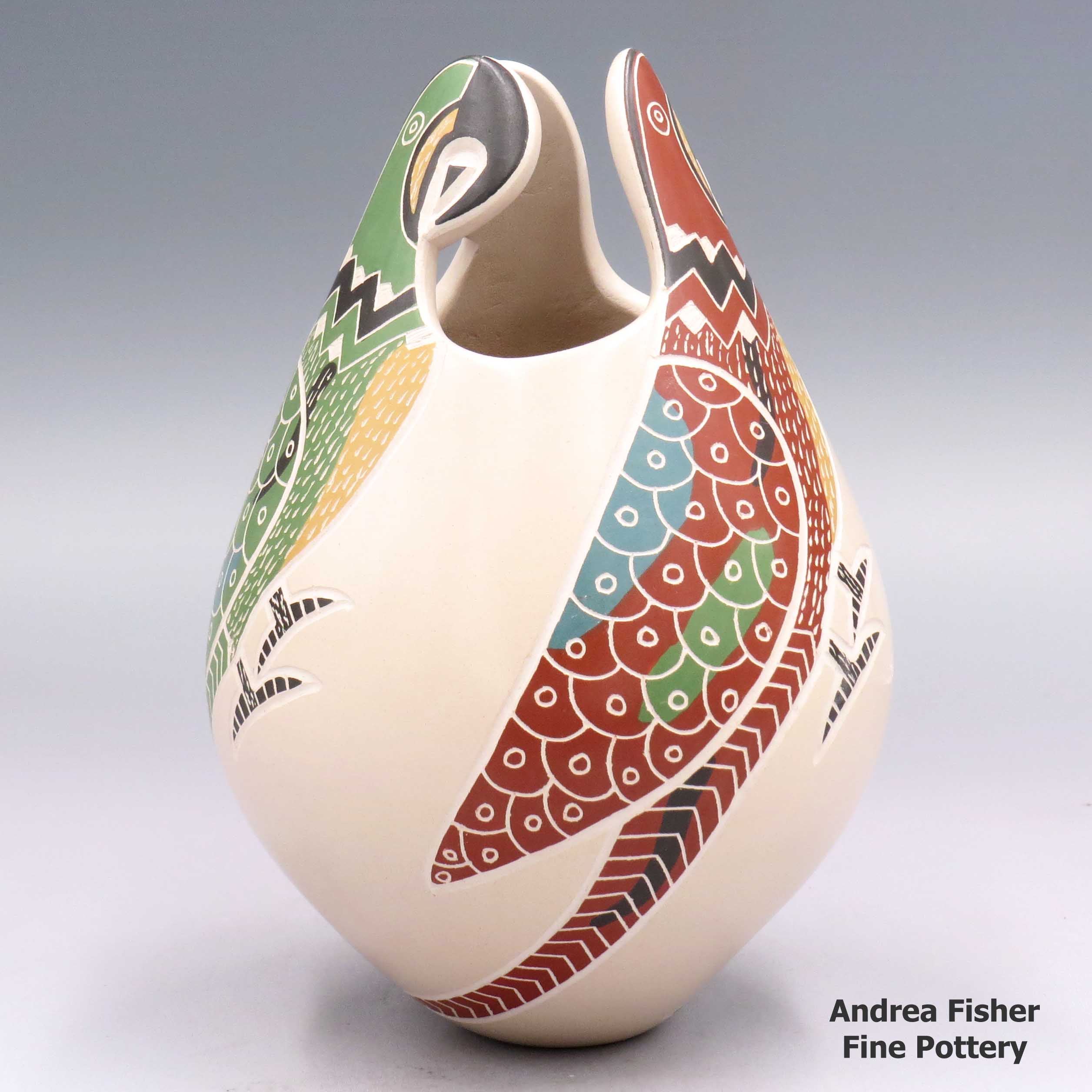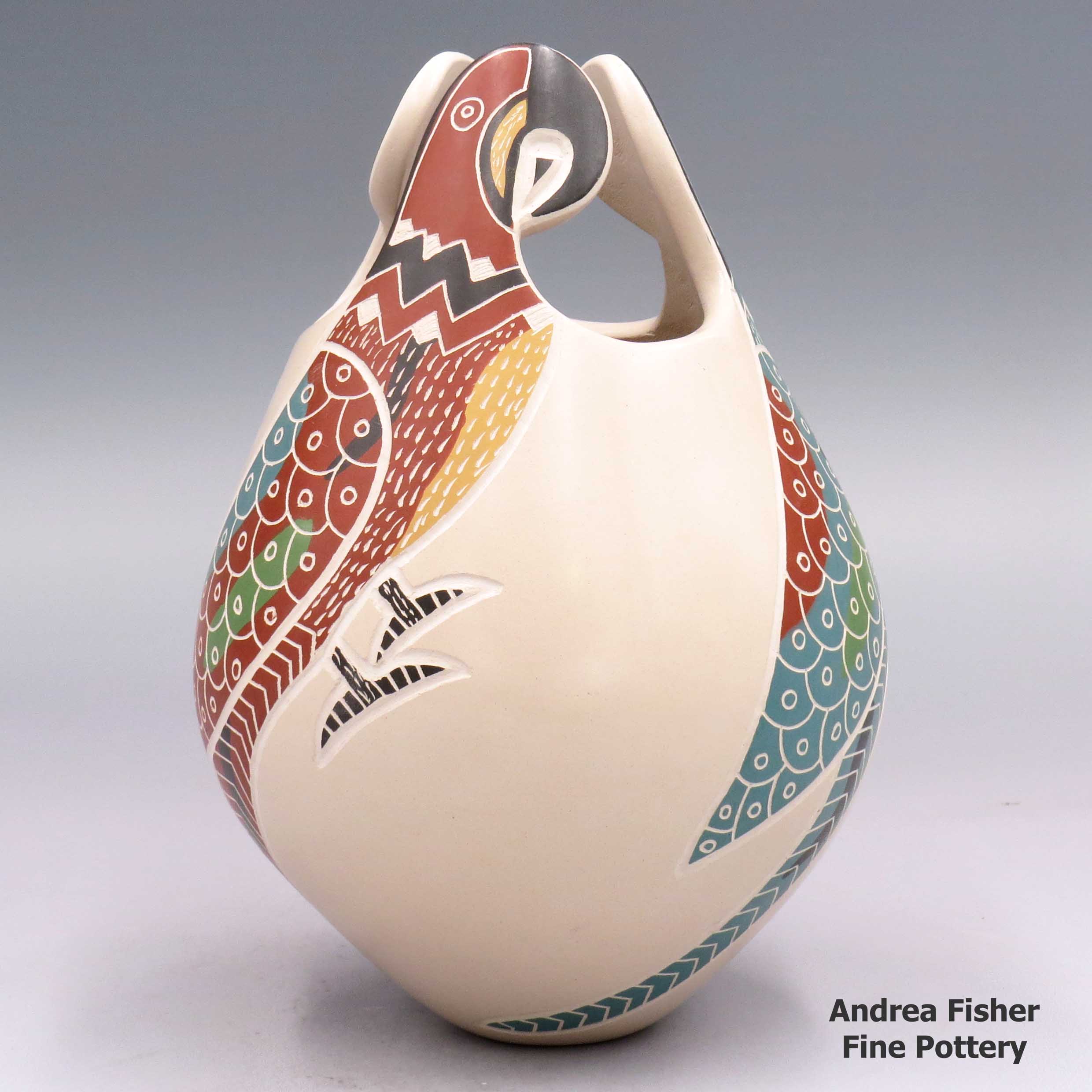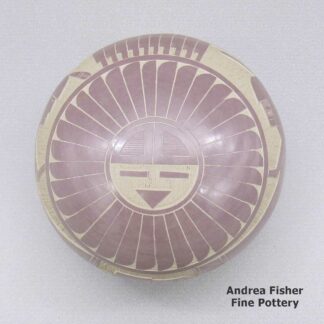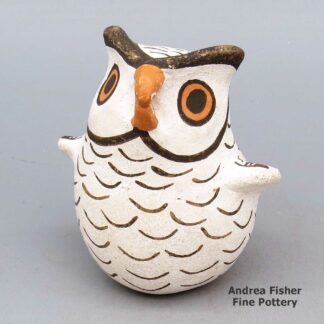| Dimensions | 4.75 × 4.75 × 6.75 in |
|---|---|
| Condition of Piece | Excellent |
| Date Born | 2021 |
| Signature | Vidal Corona |
Vidal Corona, aqcg1h552, Jar with parrot design
$295.00
Polychrome jar with a three-panel carved, sgraffito and painted parrot design
In stock
- Product Info
- About the Artist
- Home Village
- Design Source
- About the Shape
- About the Design
- Family Tree
Brand
Corona, Vidal
Vidal's signature pieces these days often offer uniquely expressive avian forms sculpted into the openings of his vessels. He then etches large and small designs into the surface of the clay, paints them in colors that match the theme of the pot and then fires them to produce his finished product. Many of his designs revolve around macaws, parrots, eagles and other birds, and butterflies.
His sister, Angela Corona, credits Vidal with teaching her how to make pottery and she has become successful in her own right, developing a distinctive series of polychrome owl effigy jars and lizard-covered seed pots.
About Mata Ortiz and Casas Grandes
Mata Ortiz is a small settlement inside the bounds of the Casas Grandes municipality, very near the site of Paquimé. The fortunes of the town have gone up and down over the years with a real economic slump happening after the local railroad repair yard was relocated to Nuevo Casas Grandes in the early 1960s. It was a village with a past and little future.
A problem around the ancient sites has been the looting of ancient pottery. From the 1950s on, someone could dig up an old pot, clean it up a bit and sell it to an American dealer (and those were everywhere) for more money than they'd make in a month with a regular job. And there's always been a shortage of regular jobs.
Many of the earliest potters in Mata Ortiz began learning to make pots when it started getting harder to find true ancient pots. So their first experiments turned out crude pottery but with a little work, their pots could be "antiqued" enough to pass muster as being ancient. Over a few years each modern potter got better and better until finally, their work could hardly be distinguished from the truly ancient. Then the Mexican Antiquities Act was passed and terror struck: because the old and the new could not be differentiated, potters were having all their property seized and their families put out of their homes because of "antiqued" pottery they made just yesterday. Things had to change almost overnight and several potters destroyed large amounts of their own inventory because it looked "antique." Then they went about rebooting the process and the product in Mata Ortiz.
For more info:
Mata Ortiz pottery at Wikipedia
Mata Ortiz at Wikipedia
Casas Grandes at Wikipedia
Contemporary Pottery
The term "contemporary" has several possible shadings in reference to Southwestern pottery. At some pueblos, it's more an indicator of a modern style of carving or etching than anything else. At San Felipe it refers to almost anything newly made there as they have almost no prehistoric templates to work from. At Jemez the situation resolved to where what makes a piece uniquely "Jemez" is the clay. Any designs on that clay can be said to be "contemporary."
About Jars
The jar is a basic utilitarian shape, a container generally for cooking food, storing grain or for carrying and storing water. The jar's outer surface is a canvas where potters have been expressing their religious visions and stories for centuries.
In Sinagua pueblos (in northern Arizona), the people made very large jars and buried them up to their openings in the floors of the hidden-most rooms in their pueblo. They kept those jars filled with water but also kept smaller jars of meat and other perishables inside those jars in the water. It's a form of refrigeration still in use among indigenous people around the world.
Where bowls tend to be low, wide and with large openings, jars tend to be more globular: taller, less wide and with smaller openings.
For a potter looking at decorating her piece, bowls are often decorated inside and out while most jars are decorated only on the outside. Jars have a natural continuity to their design surface where bowls have a natural break at the rim, effectively yielding two design surfaces on which separate or complimentary stories can be told.
Before the mid-1800s, storage jars tended to be quite large. Cooking jars and water jars varied in size depending on how many people they were designed to serve. Then came American traders with enameled metal cookware, ceramic dishes and metal eating utensils...Some pueblos embraced those traders immediately while others took several generations to let them and their innovations in. Either way, opening those doors led to the virtual collapse of utilitarian pottery-making in most pueblos by the early 1900s.
In the 1920s there was a marked shift away from the machinations of individual traders and more toward marketing Native American pottery as an artform. Maria Martinez was becoming known through her exhibitions at various major industrial fairs around the country and Nampeyo of Hano was demonstrating her art for the Fred Harvey Company at the Grand Canyon. The first few years of the Santa Fe Indian Market helped to solidify that movement and propel it forward. It took another couple generations of artists to open other venues for their art across the country and turn Native American art into the phenomenon it has become.
Today's jars are artwork, not at all for utilitarian purposes, and their shapes, sizes and decorations have evolved to reflect that shift.
About Bird Elements
One of the main tenets of the Flower World ideology is that birds are messengers to and from Paradise. They carry our prayers to Heaven and they bring back the responses. Not all the pueblos accepted the Flower World ideology but it seems almost everyone, almost everywhere, agrees that birds are the messengers of Heaven. All pueblos do have multiple designs that incorporate feathers, if feathers aren't the main element of the design.
The Flower World ideology originated in central Mexico and most likely traveled north to the pueblos in the company of missionaries and long-distance traders. Turquoise was taken south while tropical birds, copper bells, seashells, and textiles (with particular spiritual designs on them), along with other spiritual items, were taken north. Going either way, almost everyone passed by Paquimé. The trade routes from the south came together there and the trade routes to the north diverged from there. That business didn't really come together until the first structures went up in the immediate vicinity of Paquimé, around 1150 CE. Then it ended around 1450 CE when the city was abandoned. That was also the end of pilgrims making their way south and then coming north again a few years later. For more than 300 years that traffic had been a major profit center and prestige generator for the people of Paquimé and Casas Grandes. After Paquimé was abandoned, though, the trade and pilrimage routes became far more dangerous. With the advent of the Aztec Empire in central Mexico, being a foreigner in that area became far more dangerous, too. Essentially, the puebloans who had embraced the Flower World ideology were cut off from their Holy Land.
The Flower World Complex, with its symbology, flowed across the American Southwest and eventually reached the Four Corners area. But it arrived at about the same time the kachina cults were coming together and the people were abandoning the Four Corners. The Flower World ideology was felt to be greater than what had come before so it's symbology was basically imprinted on top of that. Then the designs of the kachina cults and other clans were added on top of the Flower World symbology. Then came the Europeans with their designs and spiritual practices.
One of the principals of Native American design is that it is necessary only to note one part of most animals to imply the presence of the whole, especially when it comes to birds and bird elements. A lot of the design on Hopi pottery can only be described as "bird elements," although it is often possible to discern parrot feathers from eagle feathers, and eagletails from other bird's tails.
The Zunis have an ancient "almost-spiral" design that comes from the beaks of their equally ancient "rainbirds." The Zunis also like to make owl figures as owls are a symbol of wisdom to them. To some Northern Tewas, owls are creatures to be feared.
At Acoma they have a "cloudeater," a crane pictured with neck bent over and filling with fish shown sideways in its throat as it swallows them whole. Acoma potters also have a parrot that resembles the parrot found on the sides of the boxes carried by Amish traders back in the day. The parrot is not complete without a branch with leaves, and maybe berries, in its claws.
At Santo Domingo, religious dictates limit what can be imaged on pottery offered to the public. Birds, fish, turtles and flowers are allowed, along with a vast catalog of geometric designs. Images of humans are not. Next door at Cochiti, almost anything goes
The artists of the Mata Ortiz area are resurrecting some of the designs left behind by artists of old but they have no inner connection with the Flower World. Others in today's Mata Ortiz have gone totally contemporary: carving, scratching and painting beautiful images of birds with branches, vines and flowers.
Juan Quezada Family and Teaching Tree - Mata Ortiz
Disclaimer: This "family and teaching tree" is a best effort on our part to determine who the potters are in this grouping and arrange them in a generational order/order of influence. Complicating this for Mata Ortiz is that everyone essentially teaches everyone else (including the neighbors), so it's hard to get a real lineage of family/teaching. The general information available is scant. This diagram is subject to change as we get better info.
- Juan Quezada Sr. (1940-2022) & Guillermina Olivas Reyes (1945-)
- Nicolas Quezada (1947-2011) & Maria Gloria Orozco
- Elida Quezada & Ramon Lopez
- Jose Quezada (1972-) & Marcela Herrera
- Leonel Quezada Talamontes (1977-2014)
- Reynaldo Quezada & Monserat Treviso
- Lucia Quezada
- Lupita Quezada & Hector Quintana
- Maria de los Angeles Quezada
- Maria Guadalupe Quezada
- Mariano Quezada Treviso & Rocio de Quezada
- Maria Acosta
- Fernando Andrew
- Octavio Andrew (1970-)
- Jose Cota
- Gloria Lopez
- Rosa Lopez
Rosa and Gloria's students:
- Roberto & Angela Banuelos
- Adriana Banuelos
- Diana Laura Banuelos
- Mauricio Banuelos
- Olga Quezada & Humberto Ledezma
- Roberto & Angela Banuelos
- Lydia Quezada & Rito Talavera
- Moroni Quezada (1993-)
- Pabla Quezada
- Consolacion Quezada & Guadalupe Corona Sr.
- Dora Quezada
- Guadalupe Lupe Corona Jr.
- Hilario Quezada Sr. & Matilde Olivas de Quezada
- Mauro Quezada (1968-) & Martha Martinez de Quezada
- Avelina Corona & Angel Amaya
- Mauro Corona
- Luis Baca & Carmen Fierro
- Avelina Corona & Angel Amaya
- Oscar Corona Quezada
- Octavio Gonzalez Camacho (Quezada)
- Oscar Gonzales Quezada Jr.
- Guadalupe Lupita Cota
- Reynalda Quezada & Simon Lopez
- Samuel Lopez Quezada (1972-) & Estella S. de Lopez
- Olivia Lopez Quezada & Hector Ortega
- Yolanda Lopez Quezada
- Rosa Quezada
- Noelia Hernandez Quezada (1975-)
- Paty Quezada
- Jesus Quezada
- Imelda Quezada
- Jaime Quezada
- Jose Luis Quezada Camacho
- Mary Quezada
- Genoveva Quezada & Damian Escarcega
- Damian Quezada & Elvira Antillon
- Anjelica Escarcega
- Ana Trillo
- Yesenia Escarcega
- Ivona Quezada
- Miguel Quezada
- Damian Quezada & Elvira Antillon
- Alvaro Quezada
- Arturo Quezada
- Efren Quezada
- Juan Quezada Jr. & Lourdes Luli Quintana de Quezada
- Laura Quezada
- Maria Elena Nena Quezada de Lujan
- Alondra Lujan Quezada
- Mireya Quezada
- Noe Quezada & Betty Quintana de Quezada
- Guillermina Quezada Quintana
- Ivan Quezada Quintana
- Lupita Quezada Quintana
- Taurina Baca (1961-)
- Gerardo Cota
- Guadalupe Gallegos
- Ivonne Olivas
- Manuel Manolo Rodriguez Guillen (1972-)
